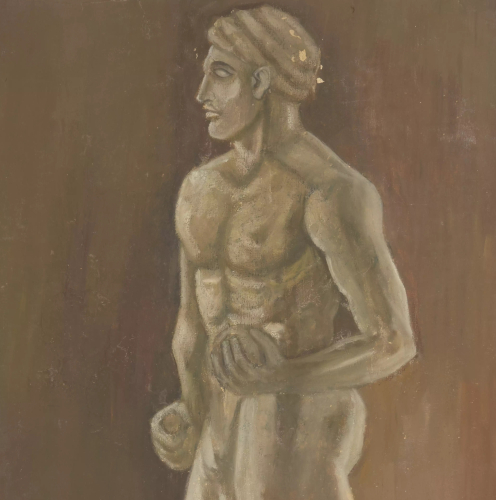Jehangir Sabavala, renowned for his elegant moustache and refined dress sense, stands as one of India's most admired and respected artists. With a career spanning six decades, Sabavala developed a unique cubist impressionist style that has captivated art enthusiasts worldwide. His artworks have garnered significant attention, including the sale of his large landscape piece, "The Hooded Day" (1970), at a Sotheby's auction in November 2019, fetching over £200,000. Born in 1922 into an affluent Parsi aristocratic family in Mumbai, India, Sabavala received training from some of the world's finest art colleges, including the Sir J.J. School of Art in Mumbai, the Heatherley School of Art in London, and the Academie Andre Lhote, the Academie Julian, and the Academic de la Grande Chaumiere in Paris.
Sabavala's artistic journey began with a solo exhibition in a hotel room at the Taj Mahal Hotel in Mumbai, with assistance from the celebrated Indian painter M.F. Husain (1915-2011). Although contemporaneous with the Progressive Artists' Group, a movement that featured prominent artists such as F. N. Souza, Akbar Padamsee, Tyeb Mehta, M.F. Husain, and S.H. Raza—who deviated from the restrained style of the Bengal School to establish a unique post-independence Indian artistic identity—Sabavala did not align himself closely with any particular group. He believed that such associations would restrict his creative expression.
Sabavala's training in Europe played a vital role in shaping his painting style. From 1947 to 1951, he studied under Andre Lhote, a French Cubist painter who imparted the principles of Cubism to him. This training encouraged Sabavala to construct objects not as they appeared to the eye but in relation to other entities. His artworks reflect this approach, where serene images symbolize fractured shards of reality. Simultaneously, Sabavala's fascination with nature, color tonality, and the depiction of India's vibrant landscapes compelled him to explore beyond pure Cubism. His canvases often feature geometric wedges merging to create vast, tranquil scenes, showcasing his mastery in creating depth and commanding the elements of light, color, and texture.
Before his passing in 2011, Jehangir Sabavala participated in over thirty solo exhibitions in India and internationally, including notable shows such as "Ricorso" at Sakshi in Mumbai and Aicon in New York (2008-09), as well as a retrospective at the National Gallery of Modern Art in Mumbai and New Delhi (2005-06). His artistic achievements were recognized with prestigious honors, including the Padma Shri from the Government of India in 1977 and the Lalit Kala Ratna from the President of India in 2007. Filmmaker Arun Khopkar immortalized Sabavala's life in the film "Colours of Absence," which received the National Film Award in 1994, the highest film accolade in India. Additionally, three monographs have been dedicated to his works.
Sabavala's artistic contributions find a place in distinguished public and private art collections worldwide, such as the National Gallery of Modern Art in New Delhi, Birla Academy of Fine Arts in Kolkata, Parliament House in New Delhi, The Punjab Government Museum in Chandigarh, Air India in Mumbai, Tata Institute of Fundamental Research in Mumbai, and The National Gallery of South Australia in Adelaide. As time passes, the celebration of his profound influence on Indian modern art continues to grow.
